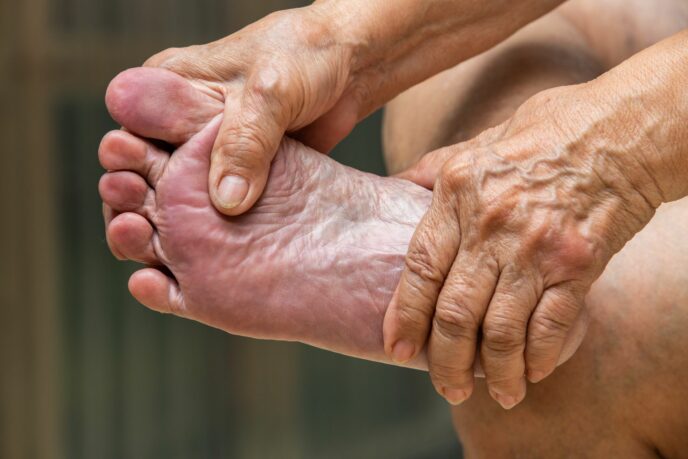
How Common is Peripheral Artery Disease
Peripheral arterial disease (PAD) is common, and unfortunately, under-diagnosed. Only 10%-20% of people who have peripheral artery disease get diagnosed and treated. It’s estimated that up to 20%-30% of the general population, by the time they reach 70-years-old, will have evidence of peripheral artery disease.
Because peripheral artery disease is under-diagnosed, patients have to be their own self-advocates. In this interview, Dr. A. Ramsey Abadir explains the symptoms, predispositions, and treatment of peripheral artery disease for you to learn more about PAD.
Who is Prone to Getting Peripheral Artery Disease?
The most common reason for the development of peripheral artery disease is genetics. Some people have genes that predispose them to building up clots and atherosclerosis in the blood vessels. However, there are three things a patient can do to address this predisposition – not smoke, lower high blood pressure and high cholesterol, and control diabetes. When our patients display evidence of peripheral artery disease, these three avenues are where we’ll intervene.
What are the Symptoms of Peripheral Artery Disease?
The symptoms of peripheral artery disease range in severity. At first, patients will notice mild pain in their legs such as cramping as they’re walking. When they stop and rest, the cramping goes away. As things get more severe, they’ll find that the distance they can walk without cramping becomes increasingly shorter. Going up hills or stairs becomes tougher.
When the symptoms become even more severe, they can have pain even when they’re not exercising or when they’re resting in bed. Patients will often tell me that they’ll be in bed, get a cramp in their leg, and have to get out of bed and walk around or hang their leg off the side of the bed to alleviate the pain. As the symptoms continue to progress, they’ll experience more troublesome findings, including gangrene in the toes or a patch of skin that turns black or brown. This patch of skin can open up into an ulcer.
How is Peripheral Artery Disease Diagnosed?
Peripheral arterial disease is typically diagnosed when these symptoms are described to either a primary care doctor or a vascular specialist like myself. Once we suspect there is trouble with the arteries, we conduct a series of simple tests.
First, we check the blood pressure in the arms and legs. Blood pressure in the leg that is lower than in the arm indicates a blockage of blood flow. This result, combined with a careful physical examination, where we check the pulses in the arms and legs, can give us further information as to the severity of the PAD. We can also perform an ultrasound in order to see the blood vessels, measure the blood flow, and determine if there’s any reduction in blood flow compared to normal. Once we’ve established the fact that there is a decrease in blood flow, either to one leg or to other parts of the body, we determine a treatment plan.
Can Peripheral Artery Disease be Reversed?
Peripheral Artery Disease is not reversible. Unfortunately, it is a progressive disease. However, we can reverse the effects by opening up the arteries and stopping the progression. Once a patient has been diagnosed with PAD, it’s important to maintain a routine follow-up so we can address issues before they become critical.
Why is Peripheral Artery Disease Dangerous if Left Untreated?
Peripheral arterial disease has a range of presentations. It usually presents as a very mild disease, manifested by a slight pain in the legs. However, if allowed to progress, which it usually does, it can get severe enough that there is critically low blood flow to the legs. In that case, there can be an onset of gangrene. If it becomes critically severe, it can progress to the point where the amputation of part of the foot, the whole foot, the leg, below the knee, and even worse is necessary.
How is Peripheral Artery Disease Treated?
Most of the time we perform an angiogram. This is a procedure where we put dye in the blood vessels through a little tube called a catheter. Then we take pictures as the dye goes down the arteries in the legs. When we see areas that are narrow, we can identify the level of obstruction. Then we can use balloons to squeeze open the arteries and restore them to a more normal diameter.
Sometimes we have to get rid of the substance that’s narrowing the arteries, which is called plaque. Plaque is a build-up of cholesterol. We have special machines that can remove plaque from the arteries. In some cases, we place a stent, which is like metal scaffolding, that sits inside the arteries and physically holds them open. With a combination of these techniques—the balloon which is called angioplasty; the removal of plaque which is called atherectomy; and the placement of the stent—we can usually increase blood flow and improve the situation.
Request an Appointment with Dr. Abadir
If you notice increasing pain in your legs when you’re walking around, or if you have an ulcer on your foot that’s not healing, ask your doctor to compare the blood pressure in your arm and your leg. Based on the results, it’s easy for your doctor to refer you to a vascular specialist who can help with further testing and treatment.
If you think you may be prone to peripheral artery disease, request an appointment with Dr. A. Ramsey Abadir at Fishkill Endovascular today. You can also schedule an appointment with our other affiliated vascular specialists at one of our vascular centers in New York and New Jersey.
Related Blogs & Videos
Learn more about vascular health, prevention, and care for Peripheral Artery Disease.




